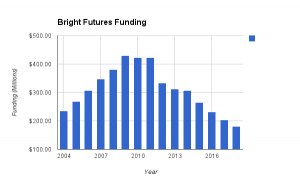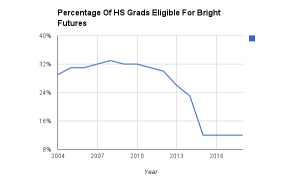New Bright Futures Rules Changing College Plans For Florida Students

John O'Connor / StateImpact Florida
Jake Seiler had to put his plans to attend the University of South Florida on hold for a year to earn an associate's degree at Palm Beach State College because he didn't qualify for Bright Futures. His dad, Paul, calls changes to Bright Futures an "injustice."
Most new Palm Beach College Students were going through orientation earlier this month, but Jake Seiler was wrapping up his first three courses.
Despite earning the highest SAT scores of his two siblings — 1100, on six attempts — Seiler didn’t score high enough this year to earn the Bright Futures Florida Medallion scholarship his older sister got last year.
That’s because Bright Futures, Florida’s lottery-funded college scholarship, has finished going through what supporters say is a fundamental change. The program has raised required test scores and become much more exclusive. Bright Futures is now exclusively a merit-based program and not focused on expanding access to higher education.
And that means students like Seiler, who once would have qualified for the scholarship with ease, no longer make the cut. And he isn’t alone.
At its peak in 2008, one in three Florida high school graduates qualified for a Bright Futures scholarship. In Seiler’s graduating class, according to estimates by the Florida College Access Network, just one in eight students will qualify.
“When I found out that I made the scores that [were] available last year, but it wasn’t this year, I was very confused,” he said. “It’s like, ‘I’m sorry I was born the wrong year.’”
Without the roughly $2,300 per year from Bright Futures, Seiler had to put his plans to attend the University of South Florida on hold. He’s plowing through his associate’s degree in one year, spending a combined 50 hours on school and a part-time job at Chipotle.
The Bright Futures program handed out its first scholarships to students entering college in 1997. The program gave out $429 million in scholarships in the 2008-2009 school year, its high-water mark.
But then the Great Recession hit, and lawmakers were forced to scale back.
More recently, said Senate Education Chairman John Legg (R-Trinity), lawmakers have turned to research for reasons to scale the program back. Legg points to an American Institutes of Research study that showed students who could meet the lower end of Bright Futures requirements were less likely to finish college than those with higher SAT or ACT scores and grade point averages.
Lawmakers have long argued about whether Florida should focus on merit- or needs-based college aid. Legg says the revamped Bright Futures sets a high standard.
“So what we wanted to do is have a realignment, if you will, of Bright Futures to make it just what it was intended – for our best and brightest,” Legg said. “We’ve taken up the access cause and injected it into Bright Futures, perhaps that’s not the best place for it.”

Florida Department of Education and Office of Economic and Demographic Research data
Bright Futures once paid $429 million in scholarships a year. Lawmakers have raised required SAT and ACT scores, and estimates are the programs will pay just $180 million by 2018.
To qualify for a Bright Futures Florida Academic Scholars award — the most selective and lucrative scholarship — students have to score at least 1290 on the SAT or 29 on the ACT. Those scores put students nearly in the top 10 percent nationwide.
In 2012 those students needed a 1270 on the SAT or 28 on the ACT.
More students qualify for the Florida Medallion Scholarship — that’s what Seiler just missed out on. Over three years, the minimum score rose from 970 to 1170 on the SAT and from 20 to 26 on the SAT.
And this year was the highest increase. The minimum SAT scored jumped by 150 points and the ACT score by 4 — at least a 15 percent increase for both tests.
The changes will also cut the cost of Bright Futures. The program paid $429 million in 2009. Bright Futures will award $180 million by 2018, according to estimates.
About 70 percent of students awarded Florida Medallion Scholarships each year renewed them, according to state data.
“There’s only so much money to go around for education. If you’re giving a merit-based award, it should be to the top students in the state,” state Rep. George Moraitis (R-Fort Lauderdale) told the Sun-Sentinel in April.
But Legg disagreed.

Florida Department of Educaiton and Office of Economic & Demographic Research data.
Just one in eight Florida high school graduates will qualify for a Bright Futures scholarship, according to estimates.
“In my view, it’s not a decision driven by money,” he said.
The tougher standards have college advocates concerned.
The Florida College Access Network crunched the numbers last year and found black and Hispanic students would be excluded at disproportionate rates to that of whites and Asians.
The changes have also drawn the attention of the U.S. Department of Education’s Office of Civil Rights. It has reopened a review of the program to determine whether the SAT and ACT requirements lead to racial discrimination.
Florida Department of Education officials said they have heard nothing from federal investigators.
Laura Perna is a University of Pennsylvania education professor who studies college access and affordability, including state-funded financial aid programs, such as Bright Futures.
She says merit-based programs, such as Bright Futures, have many advantages. They have easy-to-understand requirements. And they also entice high school graduates to stay in state for college.
But having set standards doesn’t make the scholarships fair. Some students don’t enter school as prepared as others. And wealthier students can afford outside tutoring and test prep, which is one reason standardized test results are correlated to income.
“The playing field for academic readiness is not level,” Perna says.
And she asks, what happens to students who no longer qualify for Bright Futures? Do they put off college? Do they borrow money and take on debt to pay for college?
Finance major Jake Seiler isn’t putting college off — but he is putting off his plans for the University of South Florida for a year. His friends’ Facebook posts remind him what he’s missing.
“The community. Those late nights in your dorm,” he said. “Those basketball games and football games you can be cheering for your favorite team in face paint and everything. Fraternity parties – I’m not going to lie.”
His dad, Paul, calls the changes an injustice. Lawmakers should have raised the requirements for the Florida Academic Scholars program — more generous at about $3,100 a year — further if they were concerned about the cost of Bright Futures, Paul Seiler said.
“The Bright Futures was one of those issues that said…If you’re a good student and you work hard, there’s something for you,” Paul Seiler said.
But having attended Palm Beach County’s competitive Dreyfoos School of the Arts, Jake Seiler’s gotten over the sting of spending a year at the local college.
“Literally it’s going to pay off,” he said. “I feel proud of it now. I used to be very ashamed to say I’m going to a local [college]. … I’m saving my parents money and I’m getting a good education and I’m going to be at the same university you are and graduating a year ahead of you.
“And I feel proud of that.”


